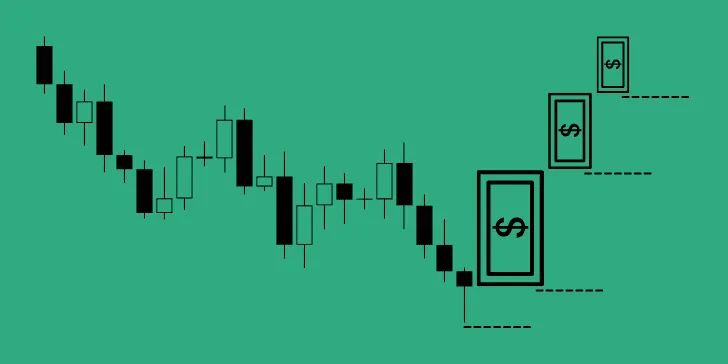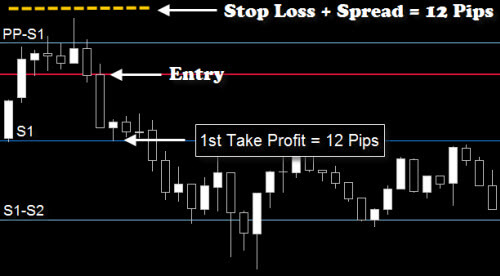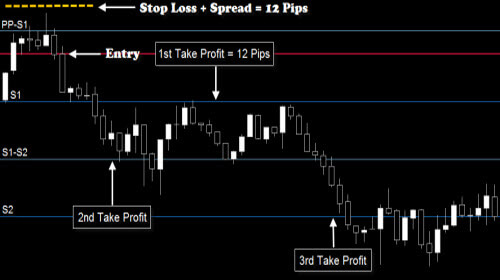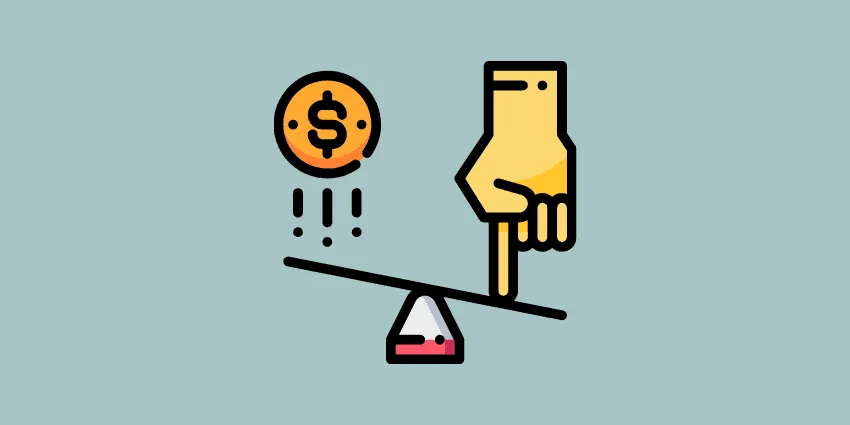
Money management is so critical in trading. Many times, money management skills are what separate winning traders from liquidity providers. I try to give money management and discipline due credit on this site.
Every trader has a different approach to trading, as far as trading systems go, and many different approaches could work for any given trader. Why then, do most traders lose in the market, and only a small percentage win consistently?
What really separates winning traders from losing traders, is not the trader’s chosen trading methodology (although a winning trading system is a must), but impeccable money management and great psychological discipline. In this article, we will focus on money management techniques, or how to keep your losses small and let your winners run.
Note: I’ve recently switched trading systems, and no longer use this money management trading technique. That being said, this technique is worth learning. See if it makes sense for your trading system. To learn more about why I switched trading systems, see my full Day Trading Forex Live review.
The Scaling Out Money Management Trading Technique
Some of this information may seem counterintuitive to you at first. It took a while for me to see the benefits of the type of money management that I’m about to describe. Earlier in my trading career, I was taught not to scale out of trading positions. In this way, price has to move less to meet your desired profit goals.
This seems to me, now, like a silly way to trade for a few reasons:
- The market simply does not care about your profit goals one bit.
- If you always get out at 1:2 or 1:3 risk/reward on good trades, you will miss the 1:4+ risk/reward scenarios.
- You practically double your risk using traditional profit goals, in comparison to the money management techniques that I’m about to show you.
The key isn’t to try to make more than 1:1 risk/reward so that your winners cover your losses (although that helps), but rather that you turn most of your failed trades into scratch/break even trades or very small losses. With a good trading system, the winners will come, and your profits (any profits) will be greater – not having to overcome previous losses.
How to Keep Your Losses Small
This section could have also been titled, “The Benefits of Scaling Out of Trading Positions,” but “How to Keep Your Losses Small” sounds more catchy. Scaling out is not typically a technique used to generate more profits, but rather a technique to alleviate risk. In this article I’m going to show you how it can do both.
I’ll use an example to explain how this works. In our example, let’s say that our trader is risking 2% per trade, and he has a trading system that works. He waits for a setup, and then enters a sell trade, marking his stop loss in a logical area and adjusting his position size to be as close to 2% as possible.
Instead of holding his entire position until it hopefully reaches a traditional profit goal, like 2-3 times his risk (or 1:2-1:3 risk/reward), he opts instead to exit half of his total position as soon as the trade moves to 1:1 risk/reward. In other words, as soon as the trade is in profit for the total amount our trader originally had at risk, he exits half of his position.
At that point, our trader no longer has anything at risk. This happens because, after his first scale out, our trader has taken a 1% profit while leaving only 1% remaining at risk (Remember: our trader was originally risking 2%). The worst he can do now is break even/scratch (see the image below).

There is no longer any risk to our trader’s capital – only risk to his potential profit. At this point, our trader may also elect to move his stop loss down to the original sell entry or lower, locking in his most recent profits (1%), and perhaps more.
That is a perfect scenario. In reality, you may not have the opportunity to reach 1:1 risk/reward before exiting half of your position. In my experience, if you have any indication that your profitable trade may come back to your entry point, you should exit at least half of your position at that time. Exit the entire trade if your original reason for entering the trade has changed.
Some helpful tips: Instead of taking your first profits at roughly 1:1 risk/reward, you could scale out at the first support/resistance level. If your trading system measures oversold and overbought cycles, you could also use cycle highs/lows as logical points to scale out of your positions.

By taking these steps, you can essentially limit most of your failed trades to break even/scratch trades or small losses. There will be some small wins in there as well, even on failed trades, if you scale out and adjust your stop loss appropriately. The key is that you are getting into low or no risk trading situations as quickly as possible.
Successful traders know how to preserve their capital. Amateur traders usually have small accounts, and risk too much thinking that they need to double their accounts in (x) amount of time. Sure, we all want to see our accounts grow, but you’ll never achieve sustainable growth until you learn to keep what you have.
How to Let Your Winners Run
Now that you’ve seen some of the benefits of scaling out of your trading positions in relation to risk management, I’m going to show you how to use these money management trading techniques to let your winning trades run for huge, stress free profits.
I’ve shown you how to get into low stress trades quickly, in our example earlier. Now lets take that same example, and say that the market continues moving downward in the direction of our trader’s remaining sell position. Where does he scale out next?
There are a few choices:
- He could scale out at roughly 2x the distance from his entry to his original stop loss (notice we’re talking about distance – not profits – here, since we’ve already scaled out).
- He could scale out at the next major area of support (hopefully this coincides or exceeds the level arrived at with method #1).
- He could scale out near the bottom of the next cycle low (again, ideally this would coincide or exceed method #1, but the market doesn’t always give us that).
Note: Method #1 could be any distance that you choose, but this method consists of what you hope the market will do. Method #2 and #3 are actually based on objective, logical money management trading techniques (see the image below).

Our trader should continue adjusting his stop loss lower, as price makes new lows. After scaling out two or three times, he would simply continue trailing price with his stop loss, until price makes a higher high and takes his stop loss out.
What you’re basically doing here is halving your positions at every new target. Using this money management trading technique, you are able to take profits at logical price targets, while keeping some of your money active in the market to ride out the majority of the move. If you trade trends or trend reversals, this technique can be exceptionally profitable.
By managing your money this way, you can occasionally capture the majority move of an entire trend, as opposed to 1:2-1:3 risk/reward. At the same time, you will risk less and be at risk for less time on most trades. In my opinion, the scaling out money management trading technique is the closest thing to stress free trading that the market will give you.




You still have the half position that is profit that can go to zero, that that’s not o risk.
ALSO if too many of your trades end up 1% profit by doing this and your losses end up 2% . Well the math isn’t good.
Hey Carl,
Thanks for the comment. I never said this technique was zero risk. There’s no such thing in trading. However, if you exit half your position at 1:1 and then you get stopped out without moving your original stop loss, that’s a scratch trade minus the spread and any other broker fees you may be charged. In other words, after you’ve closed half of your position, the only risk is to potential profit, roughly speaking.
Example: You’re risking $100. The trade goes in your favor for 1:1 reward-to-risk ($100). You close half your position, meaning you pocket $50 and leave the other $50 in the trade. Since you’re leveraged half as much as before, if the market takes out your original stop loss, now you can only lose $50 – not $100. Since you pocketed $50, that would be a scratch trade.
The idea behind this scaling out technique is that it’s easier to be right in the short term, so reducing your risk at 1:1 is a valid strategy that lots of traders use. You end up with lots of scratch trades, small wins (when you have to exit early), and some full losses too. However, you’re leaving the trade open with half of your position so you also get the occasional big win.
I don’t personally use this type of risk management strategy anymore. The system I use now, DTFL, uses a reward to risk ratio of 2:1. However, I’ve used this exact strategy before when I was trading other systems. It does work. The math is fine. It all depends on the system and the trader. You have to be patient enough to keep trading for the big wins. 1 or 2 of those can make your whole month.
How to found this indicator
What indicator?